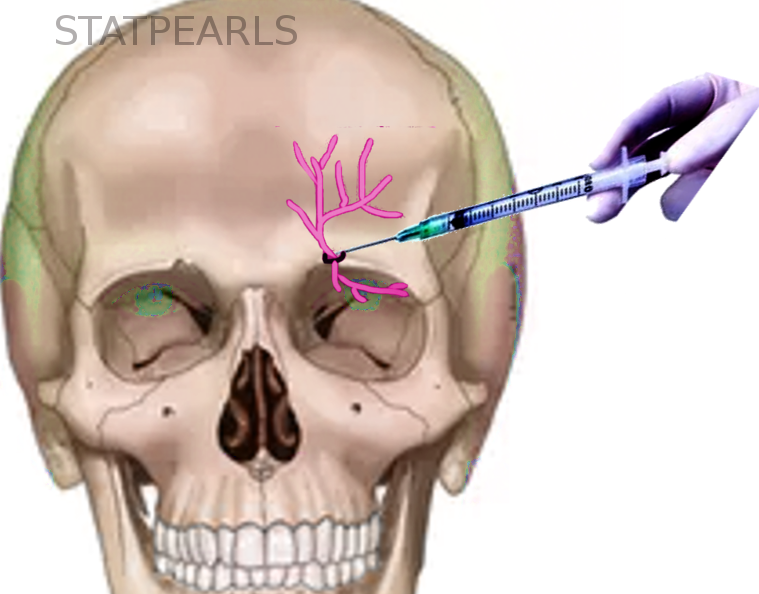[1]
De Buck F, Devroe S, Missant C, Van de Velde M. Regional anesthesia outside the operating room: indications and techniques. Current opinion in anaesthesiology. 2012 Aug:25(4):501-7. doi: 10.1097/ACO.0b013e3283556f58. Epub
[PubMed PMID: 22673788]
Level 3 (low-level) evidence
[2]
Joo W, Yoshioka F, Funaki T, Mizokami K, Rhoton AL Jr. Microsurgical anatomy of the trigeminal nerve. Clinical anatomy (New York, N.Y.). 2014 Jan:27(1):61-88. doi: 10.1002/ca.22330. Epub 2013 Dec 9
[PubMed PMID: 24323792]
[3]
Tomaszewska A, Kwiatkowska B, Jankauskas R. The localization of the supraorbital notch or foramen is crucial for headache and supraorbital neuralgia avoiding and treatment. Anatomical record (Hoboken, N.J. : 2007). 2012 Sep:295(9):1494-503. doi: 10.1002/ar.22534. Epub 2012 Jul 16
[PubMed PMID: 22807312]
[4]
Shin KJ, Shin HJ, Lee SH, Song WC, Koh KS, Gil YC. Emerging Points of the Supraorbital and Supratrochlear Nerves in the Supraorbital Margin With Reference to the Lacrimal Caruncle: Implications for Regional Nerve Block in Upper Eyelid and Dermatologic Surgery. Dermatologic surgery : official publication for American Society for Dermatologic Surgery [et al.]. 2016 Aug:42(8):992-8. doi: 10.1097/DSS.0000000000000818. Epub
[PubMed PMID: 27355574]
[5]
Allam AE, Khalil AAF, Eltawab BA, Wu WT, Chang KV. Ultrasound-Guided Intervention for Treatment of Trigeminal Neuralgia: An Updated Review of Anatomy and Techniques. Pain research & management. 2018:2018():5480728. doi: 10.1155/2018/5480728. Epub 2018 Apr 2
[PubMed PMID: 29808105]
[6]
Nanayakkara D, Manawaratne R, Sampath H, Vadysinghe A, Peiris R. Supraorbital nerve exits: positional variations and localization relative to surgical landmarks. Anatomy & cell biology. 2018 Mar:51(1):19-24. doi: 10.5115/acb.2018.51.1.19. Epub 2018 Mar 28
[PubMed PMID: 29644106]
[7]
Knize DM. A study of the supraorbital nerve. Plastic and reconstructive surgery. 1995 Sep:96(3):564-9
[PubMed PMID: 7638280]
[8]
Ferrera PC, Chandler R. Anesthesia in the emergency setting: Part II. Head and neck, eye and rib injuries. American family physician. 1994 Sep 15:50(4):797-800
[PubMed PMID: 8079909]
[9]
Eker HE, Yalçın Çok O, Açıl M, Ülger H, Arıboğan A. [Modified van-Lint technique for the management of postherpetic neuralgia: case report]. Agri : Agri (Algoloji) Dernegi'nin Yayin organidir = The journal of the Turkish Society of Algology. 2011 Apr:23(2):84-7
[PubMed PMID: 21644109]
Level 3 (low-level) evidence
[10]
Yamanaka D, Kawano T, Shigematsu-Locatelli M, Nishigaki A, Kitamura S, Aoyama B, Tateiwa H, Kitaoka N, Yokoyama M. Peripheral nerve block with a high concentration of tetracaine dissolved in bupivacaine for intractable post-herpetic itch: a case report. JA clinical reports. 2016:2(1):43. doi: 10.1186/s40981-016-0069-y. Epub 2016 Dec 5
[PubMed PMID: 29492438]
Level 3 (low-level) evidence
[11]
Özer D, Bölük C, Türk Börü Ü, Altun D, Taşdemir M, Köseoğlu Toksoy C. Greater occipital and supraorbital nerve blockade for the preventive treatment of migraine: a single-blind, randomized, placebo-controlled study. Current medical research and opinion. 2019 May:35(5):909-915. doi: 10.1080/03007995.2018.1532403. Epub 2018 Oct 31
[PubMed PMID: 30285507]
Level 3 (low-level) evidence
[12]
Santos Lasaosa S, Gago Veiga A, Guerrero Peral ÁL, Viguera Romero J, Pozo-Rosich P. Patterns of anaesthetic pericranial nerve block in headache patients. Neurologia. 2018 Apr:33(3):160-164. doi: 10.1016/j.nrl.2016.05.016. Epub 2016 Jul 25
[PubMed PMID: 27461182]
[13]
Ilhan Alp S, Alp R. Supraorbital and infraorbital nerve blockade in migraine patients: results of 6-month clinical follow-up. European review for medical and pharmacological sciences. 2013 Jul:17(13):1778-81
[PubMed PMID: 23852904]
[14]
Pareja JA, López-Ruiz P, Mayo D, Villar-Quiles RN, Cárcamo A, Gutiérrez-Viedma Á, Lastarria CP, Romeral M, Yangüela J, Cuadrado ML. Supratrochlear Neuralgia: A Prospective Case Series of 15 Patients. Headache. 2017 Oct:57(9):1433-1442. doi: 10.1111/head.13158. Epub 2017 Aug 18
[PubMed PMID: 28833061]
Level 2 (mid-level) evidence
[15]
Sjaastad O, Stolt-Nielsen A, Pareja JA, Fredriksen TA, Vincent M. Supraorbital neuralgia. On the clinical manifestations and a possible therapeutic approach. Headache. 1999 Mar:39(3):204-12
[PubMed PMID: 15613215]
[16]
Perloff MD, Chung JS. Urgent care peripheral nerve blocks for refractory trigeminal neuralgia. The American journal of emergency medicine. 2018 Nov:36(11):2058-2060. doi: 10.1016/j.ajem.2018.08.019. Epub 2018 Aug 8
[PubMed PMID: 30119988]
[17]
Tay E, Gupta M, Franks W. Supraorbital nerve block in trabeculectomy surgery: an observational case series. Clinical & experimental ophthalmology. 2006 Sep-Oct:34(7):637-9
[PubMed PMID: 16970754]
Level 2 (mid-level) evidence
[18]
Ismail AR, Anthony T, Mordant DJ, MacLean H. Regional nerve block of the upper eyelid in oculoplastic surgery. European journal of ophthalmology. 2006 Jul-Aug:16(4):509-13
[PubMed PMID: 16952086]
[19]
Chaki T, Sugino S, Janicki PK, Ishioka Y, Hatakeyama Y, Hayase T, Kaneuchi-Yamashita M, Kohri N, Yamakage M. Efficacy and Safety of a Lidocaine and Ropivacaine Mixture for Scalp Nerve Block and Local Infiltration Anesthesia in Patients Undergoing Awake Craniotomy. Journal of neurosurgical anesthesiology. 2016 Jan:28(1):1-5. doi: 10.1097/ANA.0000000000000149. Epub
[PubMed PMID: 25493926]
[20]
Kerscher C, Zimmermann M, Graf BM, Hansen E. [Scalp blocks. A useful technique for neurosurgery, dermatology, plastic surgery and pain therapy]. Der Anaesthesist. 2009 Sep:58(9):949-58; quiz 959-60. doi: 10.1007/s00101-009-1604-2. Epub
[PubMed PMID: 19779756]
[21]
Kocuj F, Epple J, Polarz H, Tronnier VM, Martin E. Nerve blocks in stereotactic neurosurgery. Stereotactic and functional neurosurgery. 2002:78(1):29-38
[PubMed PMID: 12381883]
[22]
Guerrero ÁL, Herrero-Velázquez S, Peñas ML, Mulero P, Pedraza MI, Cortijo E, Fernández R. Peripheral nerve blocks: a therapeutic alternative for hemicrania continua. Cephalalgia : an international journal of headache. 2012 Apr:32(6):505-8. doi: 10.1177/0333102412439800. Epub 2012 Mar 21
[PubMed PMID: 22436371]
[23]
Monarca C, Rizzo MI, Corrias F, Marcasciano M, Parisi P, Scuderi N. Supraorbital and supratrochlear nerves block for oncologic surgery of the anterior scalp and forehead in the elderly. Annali italiani di chirurgia. 2012 Jan-Feb:83(1):79-80
[PubMed PMID: 22352224]
[24]
Jiménez-Almonte JH, Wyles CC, Wyles SP, Norambuena-Morales GA, Báez PJ, Murad MH, Sierra RJ. Is Local Infiltration Analgesia Superior to Peripheral Nerve Blockade for Pain Management After THA: A Network Meta-analysis. Clinical orthopaedics and related research. 2016 Feb:474(2):495-516. doi: 10.1007/s11999-015-4619-9. Epub 2015 Nov 16
[PubMed PMID: 26573322]
Level 1 (high-level) evidence
[25]
Wadlund DL. Local Anesthetic Systemic Toxicity. AORN journal. 2017 Nov:106(5):367-377. doi: 10.1016/j.aorn.2017.08.015. Epub
[PubMed PMID: 29107256]

